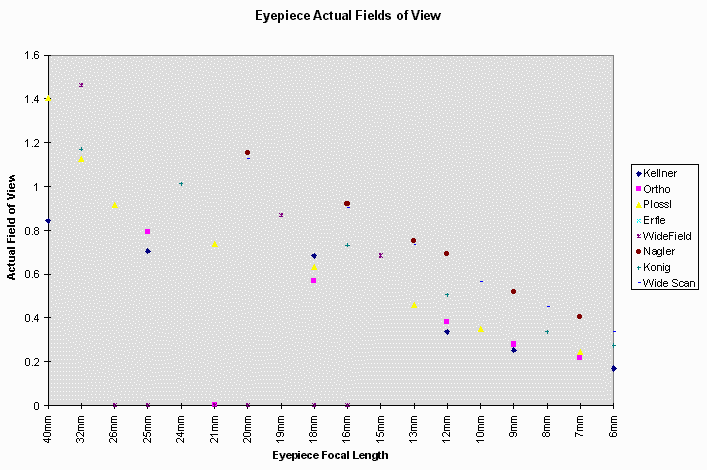Eyepiece Actual Fields of View
Jack Kramer
Everyone is pretty well aware that certain eyepiece designs present wider fields of view than others. Generally, the more expensive an eyepiece, the wider is its field of view. However, there are two types of "fields":
Apparent field is how wide an angle of view there seems to be as you look through an eyepiece. This is generally the field that is touted in the advertisements for eyepieces. The range runs from about 35o for old designs to 82o for the newer very wide field oculars. You can get a good idea about an eyepiece just by looking through it in broad daylight. If you feel like you're looking down a tunnel when you peer through the eye lens, then you've got a fairly narrow apparent field.
Actual Field is probably more meaningful because that's how many degrees of sky you're actually seeing with that eyepiece. This varies depending on the telescope. Probably the simplest way to calculate the actual field is by dividing the stated apparent field by the magnification that the eyepiece gives in your scope. For the same eyepiece design, a lower magnification (longer focal length) will show you a wider view of the sky. Anything around a one-degree actual field is pretty wide.
A few months ago, I was teaching myself to use the Excel spreadsheet program and needed some figures to play around with, so I set up a spreadsheet that showed the magnifications and fields of various eyepieces when used with my 10" scope of 1422mm focal length. I used Excel to create the following scatter chart that graphically illustrates how the different eyepieces compare in terms of their actual fields of view. While the actual fields depend on the specific telescope with which the eyepiece is paired, the appearance of the graph will be essentially the same for any telescope. The apparent fields are the same and the variance of actual fields corresponds to the telescope focal length. Of course, you didn't need a graph to show you that! But the graph readily depicts that the differences between eyepiece designs becomes greater as the focal lengths of the eyepieces increase. Stated another way, the field of view increases more dramatically with wide field oculars used at low power.
What this doesn't compare is the different image characteristics of the eyepieces, such as field flatness, edge distortion, internal reflections, etc. Sometimes a simpler eyepiece is preferable; although it has a narrower field of view, it may provide sharper and brighter images.
 Published in the September 1994 issue of the NightTimes
Published in the September 1994 issue of the NightTimes





